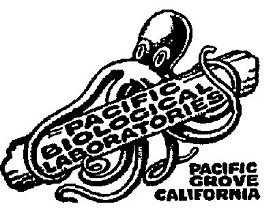- Pacific Biological Laboratories
Infobox Historic building

caption=
name= Pacific Biological Laboratories
location_town= Monterey, California
location_country= United States
architect=
client= Ed Ricketts
engineer=
construction_start_date=
completion_date=
date_demolished=
cost=
structural_system=
style=|Pacific Biological Laboratories (PBL) was a biological supply house that sold preserved animals and prepared slides to schools and research institutions.
The company was started by
Ed Ricketts with his college roommate and business partner Albert Galigher in 1923. Originally located inPacific Grove at 165 Fountain Avenue, [cite book
last =Seavey
first =Kent
authorlink =
title =Pacific Grove
publisher =Arcadia Publishing
date =2005
pages =110
isbn =0738529648 ] [Cite web | url=http://www.caviews.com/ricketts.htm| title=Edward F. Ricketts, he is not "Doc" | accessdate=2007-10-08| publisher=www.caviews.com] the lab was moved to 740 Ocean View Avenue,Monterey, California around January, 1930,cite book
last =Tamm
first =Eric Enno
title =Beyond the Outer Shores
publisher =Four Walls Eight Windows
date =2004
pages =4
isbn =1568582986 ] where Ricketts became sole owner. Today, that location is 800 Cannery Row. After developing marital problems with his first wife Anna, the lab served as Ricketts's home for some time beginning in 1936. [Cite web | url=http://www.ecotopia.org/ehof/ricketts/index.html| title=Ecology Hall of FameEd Ricketts1897-1948accessdate=2007-08-10| publisher=www.ecotopia.org] The business was fictionalized as "Western Biological Laboritories" in
John Steinbeck 's, "Cannery Row". [cite book
last1 = McElrath | first1 = Joseph R.
last2 = Crisler | first2 = Jesse S.
last3 = Shillinglaw | first3 = Susan
title =Pacific Grove
publisher =Cambridge University
date =1996
pages =372
isbn =052141038X ]On November 25, 1936, a fire broke out at the Del Mar Cannery next to the lab and most of the contents of the laboratory were destroyed. The manuscript for "
Between Pacific Tides " survived the fire as it had already been sent toStanford University for publication. The lab had been a meeting place for intellectuals, artists, and writers, includingBruce Ariss ,Joseph Campbell ,Henry Miller ,John Steinbeck ,Lincoln Steffens , andFrancis Whitaker . It was Steinbeck that saved the lab financially after the fire with the purchase of half the companies stock. [cite book |title = Beyond the Outer Shores| last=Tamm| first=Eric| publisher = Four Walls Eight Windows|year = 2004| pages = 49| isbn=052141038X] After his death the lab was bought by many of Ricketts old friends who continued meeting there every Wednesday evening very much like in the past. They sold the building to the city of Monterey in 1993. It was restored by the Cannery Row Foundation which was given the Governor's Award for Historic Preservation.The onset of
World War II led to the decline of the commercial operation of the lab, however the legacy of the specimens collected and distributed by PBL lives on. Museums throughout the United States contain specimens collected by Ricketts, including the Field Museum in Chicago, theSmithsonian Institution , theCalifornia Academy of Sciences , theAmerican Museum of Natural History , theMuseum of Comparative Zoology atHarvard University and the Museum of Zoology atLund University in Sweden.On May 14, 1997, the 100th anniversary of Ricketts' birth, a commemorative plaque was placed on the 165 Fountain Avenue location by the Pacific Grove Heritage Society and the Pacific Grove Museum of Natural History Association.
References
Wikimedia Foundation. 2010.
